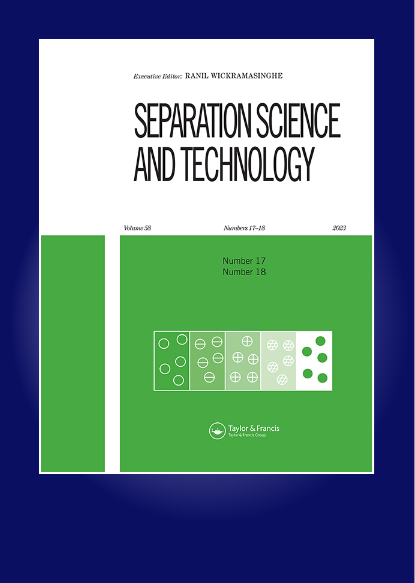负载Al/Ti元素壳聚糖去除水中砷的研究
IF 2.3
4区 工程技术
Q3 CHEMISTRY, MULTIDISCIPLINARY
引用次数: 0
摘要
摘要在含砷水溶液中除砷的过程中,通常会排放大量有害的含砷废物。本文提出了一种可回收、环保的Al/ ti负载壳聚糖(ATC)脱除砷的方法。结果表明,室温条件下,ATC对pH为8的砷的吸附效果最好。此外,Al、Ti与壳聚糖(CB)的比例影响ATC对砷的吸附效果。当Al: Ti: CB为1:1:10时,砷的去除率高达99%。ATC能在30 min内快速吸附砷,吸附动力学表明ATC对砷的吸附是物理吸附和化学沉淀共同作用的结果。吸附等温线表明吸附过程为多层吸附。最后,ATC具有良好的回收能力,是处理含砷水溶液的高效除砷剂。它在含重金属水溶液的修复中显示出巨大的潜力。关键词:砷水溶液;壳聚糖;动力学;Al/Ti负载壳聚糖对高砷水溶液中砷的有效去除。Al/Ti负载壳聚糖可再生和连续使用披露声明没有潜在的利益冲突报道新颖声明在含砷水溶液中除砷的过程中,通常会排放大量有害的含砷废物。本文提出了一种可回收、环保的Al/Ti负载壳聚糖(ATC)高效去除砷的方法。结果表明:室温条件下,ATC对含砷水溶液的砷去除率可达99%,砷浓度由200 mg/L降至10 μg/L;ATC的最高除砷能力可达45 mg/g。ATC是处理含砷水溶液的高效除砷剂。它在含重金属水溶液的修复中显示出巨大的潜力。项目资助:国家自然科学基金项目(批准号:52160011);云南省“万人计划”青年人才培养基金项目(批准号:52160011);昆明理工大学校企合作项目(KKRD201952029);KKZ4201552002)。本文章由计算机程序翻译,如有差异,请以英文原文为准。
Arsenic removal from aqueous solution by chitosan loaded with Al/Ti elements
ABSTRACTIn the process of removing arsenic in an arsenic-containing aqueous solution, a large amount of harmful arsenic-containing waste is usually discharged. In this paper, a recyclable and environmentally friendly method of removing arsenic with Al/Ti-supported chitosan (ATC) was proposed. The results show that ATC has the best adsorption effect on arsenic at pH 8 at room temperature. In addition, the ratio of Al and Ti to chitosan (CB) affects the adsorption effect of ATC on arsenic. When Al: Ti: CB is 1:1:10, the removal rate of arsenic is as high as 99%. ATC can rapidly adsorb arsenic within 30 min. The adsorption kinetics shows that the adsorption of ATC on arsenic follows the joint action of physical adsorption and chemical precipitation. The adsorption isotherm shows that the adsorption process is multilayer adsorption. Finally, ATC has good recycling ability and is an efficient arsenic-removing agent in the treatment of arsenic-containing aqueous solutions. It shows great potential in the remediation of heavy metal-containing aqueous solutions.KEYWORDS: Arsenicaqueous solutionchitosanadsorptiondynamics Highlights The formation of Al/Ti loaded-chitosan is simple and economical.Effective removal of arsenic from high-arsenic aqueous solution using Al/Ti loaded-chitosan.Al/Ti loaded-chitosan can be regenerated and continuously useDisclosure statementNo potential conflict of interest was reported by the authorStatement of noveltyIn the process of removing arsenic from arsenic-bearing aqueous solution, a large amount of hazardous arsenic-bearing waste is usually discharged. We propose a recyclable and environmentally friendly method for the efficient removal of arsenic using Al/Ti loaded-chitosan (ATC). The results show 99% of arsenic could be removed from arsenic-bearing aqueous solution and reduce the arsenic concentration from 200 mg/L to 10 μg/L using ATC at room temperature. The highest arsenic removal capacity of ATC reaches 45 mg/g due to the superior arsenic adsorption. ATC acts as a highly effective arsenic remover for the disposal of arsenic-bearing aqueous solution. It shows great potential for the remediation of aqueous solution containing heavy metals.Supplementary materialSupplemental data for this article can be accessed online at https://doi.org/10.1080/01496395.2023.2250550Additional informationFundingThis project is supported by the National Natural Science Foundation of China (Grant No. 52160011), the Yunnan Province Ten Thousand Talents Plan Young Talents Training Fund (No. KKRD201952029), the University-Enterprise Cooperation Project of Kunming University of Science and Technology (No. KKZ4201552002).
求助全文
通过发布文献求助,成功后即可免费获取论文全文。
去求助
来源期刊

Separation Science and Technology
工程技术-工程:化工
CiteScore
6.10
自引率
3.60%
发文量
131
审稿时长
5.7 months
期刊介绍:
This international journal deals with fundamental and applied aspects of separation processes related to a number of fields. A wide range of topics are covered in the journal including adsorption, membranes, extraction, distillation, absorption, centrifugation, crystallization, precipitation, reactive separations, hybrid processes, continuous separations, carbon capture, flocculation and magnetic separations. The journal focuses on state of the art preparative separations and theoretical contributions to the field of separation science. Applications include environmental, energy, water, and biotechnology. The journal does not publish analytical separation papers unless they contain new fundamental contributions to the field of separation science.
 求助内容:
求助内容: 应助结果提醒方式:
应助结果提醒方式:


